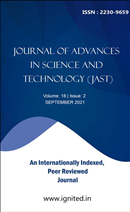A Study of Magnetic Moment Studies of Magnetostriction on Cofe204
Impact of Manufacturing Processes and Particle Size on Magnetic and Electrical Properties of Ferrites
Keywords:
magnetic moment studies, magnetostriction, ferrites, chemical composition, microstructure, manufacturing process, grain size, magnetic permeability, power loss, sintering, heating rate, cooling rate, sintering time, sintering atmosphere, particle size, starting powders, ball milling technique, low temperature methods, syntheses, Nanosized ferrite particles, sinterability, surface to volume ratio, density, porosity, magnetostriction studies, ferrimagnetic spinels, crystallographic transitions, magnetite, cobalt substituted magnetite, polycrystalline cobalt, magnetostriction constants, single crystals, MFe204, Mn, Fe, Co, Ni, Zn, proportionsAbstract
The magnetic and electrical properties of ferrites are sensitive to the changes in their chemicalcomposition as well as microstructure, which are greatly influenced by the manufacturing process. Forexample, controlling the grain size has a larger impact on the magnetic permeability and power loss in thecase of Mn-Zn and Ni-Zn ferrites. Different processing parameters such as use of external additives duringsintering, heating rate, cooling rate, sintering time and sintering atmosphere, affect the performance ofthese materials. It is known that the sintering behavior of the ferrite is considerable affected by the particlesize of the starting powders. The particle size in the starting powders can be reduced to sub-micron orNanosized levels by using ball milling technique or by employing different low temperature methods ofsyntheses. The sintering behavior of powders containing sub-micron or nanoparticles is different ascompared to their bulk counterparts. Nanosized ferrite particles have more sinterability due to their fineparticle nature as well as the high surface to volume ratio. The sintered products derived fromNanocrystalline ferrite powders exhibit improved magnetic permeability which depends on themicrostructure, density, porosity, grain size, etc., as compared to the materials sintered from the bulkcounterparts. Magnetostriction studies on ferrimagnetic spinels have been initiated in the 1950s.Domenicali has studied the magnetostriction of magnetite in order to study the crystallographictransitions at low temperature. Bickford et al. have analyzed the magnetostriction behavior of magnetiteand cobalt substituted magnetite, and showed that polycrystalline cobalt containing magnetite exhibitsvery high strains. The magnetostriction constants of single crystals of MFe204, where M stands for Mn,Fe, Co, Ni, and Zn in various proportions, have been determined by Bozorth using the method of straingages.Downloads
Download data is not yet available.
Published
2021-09-01
Issue
Section
Articles






